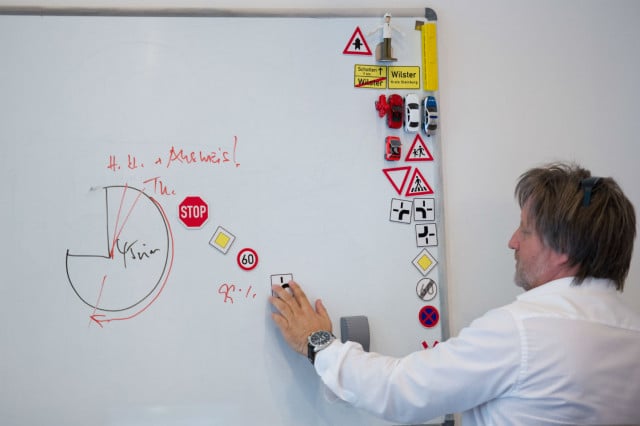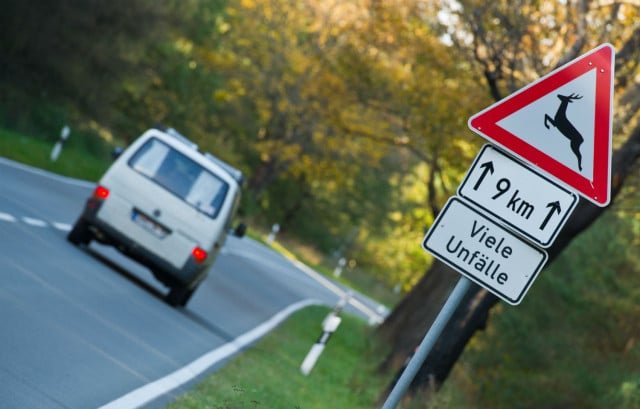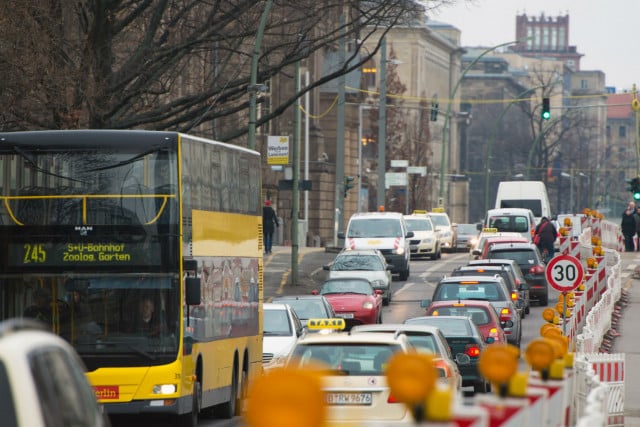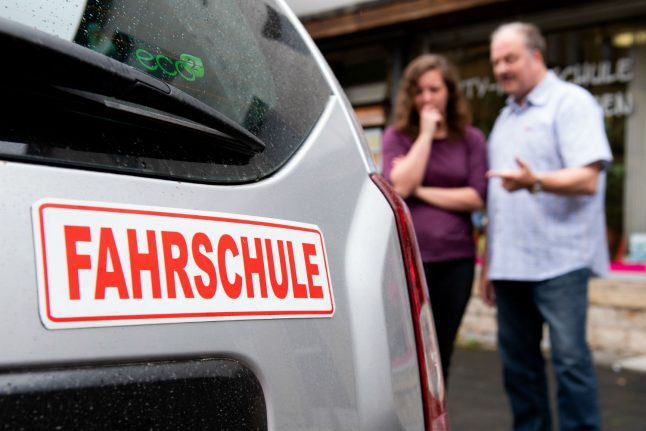My failure to secure a driving license in my homeland became a dim and irrelevant memory during my first couple of years in Berlin. But when I found myself co-owning a car which I had to rely on my bandmates to drive, I felt it was again time to face up to this final hurdle on my path to adulthood and get myself a driving license.
There are hundreds of driving schools in Berlin and the experience doesn’t come cheap. The average school charges around €30 for a 40-minute drive and, like everything else in Germany, gaining a license entails numerous bureaucratic milestones.
READ ALSO: What you need to know about getting a German driving license
For example, unlike in the UK, new drivers have to complete an obligatory first aid course and sight exam before being allowed behind the wheel. I was also horrified to learn that I would have to attend 14 90-minute-long theory lessons just to sit the theory exam (in the UK, you just get a book, learn the rules and go and do a test).

Back to school – attending driving theory lessons is a must in Germany. Photo: DPA
Mainly on the basis of its convenient location, I chose a driving school which was just a five minute walk from my flat in Friedrichshain.
After my first meeting with the proprietress of the school, I felt persuaded that this would be a good place to learn, as it seemed to have a family (they had apparently taught star boxer Wladimir Klitschko and his brother).
I put the first hair-raising adventure with my new driving instructor down as being part of the “learning to drive experience” in Germany. Over the course of six months we developed a strange love-hate relationship and I appreciated the novel company of a seventy-five year old native Berliner.
I listened with interest to his stories of his time in the Volksarmee and about how Berlin had changed. However, these pleasantries continued to be interspersed with outbursts of rage, which on several occasions even brought me to tears and soon I found myself feeling panicky before every lesson.
But, convincing myself that this was all just a test of my mettle, I stuck it out with him. We completed all of the “Sonderfahrten” (extra drives) together – 135 minutes of night time driving, 235 minutes across country and a terrifying 180 Minutes on the Autobahn. I studied religiously for my exam, using the ADAC app on my phone.
But everything finally fell apart on the day of my practical exam. In the forty minutes before the test – an obligation by most driving schools intended to warm you up beforehand, I was already very anxious. My beloved teacher shouted at me twice, so I arrived at the test centre a crying, shaking bag of nerves. The exam was over within five minutes.
This time I didn’t have the chance to commit any serious errors – I just couldn’t drive. It was a “Zusammenbruch” (breakdown).
When my teacher commiserated me, he didn’t seem to comprehend the fact that his conduct significantly contributed to my failure (which, by the way was a very expensive five minutes: €91.75 for the test centre + €125 for the driving school).
However, I managed to summon the courage to tell him that no, I wouldn’t be doing the test with him or his driving school again. He dismissed this as “Quatsch” (nonsense) and that was the last time we saw each other.

Countryside drives are another uniquely German obligation for learner drivers. Photo: DPA
Berlin driving school, take two
So, then it was onto the next driving school, where my account of the experience with the previous establishment was met with sympathetic head shaking.
The “Mitarbeiterin” (female employee) assured me that none of their drivers would ever shout at anyone and paired me up with a teacher who was apparently particularly “beliebt” (popular) with female learners.
My new driving instructor did indeed seem much calmer and friendlier than his predecessor: a man in his sixties from western Berlin, who went on lots of holidays and had lots of grandkids. I began to relax a bit in the car and started feeling more prepared for the test than I ever had with the previous school. But it was still far from paradise. I started to notice that we never drove the full 80 minutes – we always started a little late or ended a little early.
On numerous occasions his friendliness gave way to irritability and impatience and I began to feel the familiar feeling of panic creeping up on me.
The second driving test progressed a bit further. I managed about twenty minutes before the “beep” of my instructor’s foot on the brakes signalled my major error of failing to observe the “Rechts vor Links” (right before left) rule at a junction in Marzahn.
Slumped in the passenger seat on the way back to the test centre, I listened with irritation to my teacher and tester discussing my failings in what I found to be a condescending way.
I felt like a silly little girl.
Shifting gears for a third time
After the second failure, I decided to take a break from driving for a few months, not least because I had run out of cash (at this point I was out around €2000 euros). But when the time finally came to get back in the driver’s seat, I decided it was time to find a teacher who would really help me.
I initially hoped to find a female instructor, but as that proved difficult, I settled for another school near my work and for a teacher, who (as I was assured by the manager) was “am ruhigsten” (the calmest) in this driving school.

Traffic and construction sites – Berlin is not the easiest place to learn. Source: DPA
My third and final instructor in Berlin was a naturalized Turkish native who had a very laid-back style. Before each lesson, he would saunter into the driving school and hand me the keys to the car while he casually finished his cigarette.
At first, I was a bit sceptical, but within the first half an hour of driving, he said that he could see that I had been “beschädigt” (damaged) by my previous instructors and that it was his job to calm me down and to build up my confidence.
The lessons with him were much smoother than any I had before, and his compliments and encouragement helped me a lot. We shared stories of being Ausländer (foreigners) in Berlin and seemed to have an affinity in this sense.
In our final lesson before the test, he told me to think about everything I had achieved, coming to this country as a foreigner, learning the language, to finding a job and a home here. Driving was nothing too difficult for me and these motivating words rang in my ears the next day during the test.
Feeling, for the first time in the test situation, fully supported by my driving instructor in the passenger seat, I managed to drive the full 45 minutes without hearing the fatal “beep” from the brakes. My heart leaped with joy when the tester reached over from the back of the car, declaring “Herzlichen Glückwunsch” (Congratulations) as he handed me my Führerschein.
Finally, my year-long ordeal was over and my life as a driver could begin.



 Please whitelist us to continue reading.
Please whitelist us to continue reading.
Member comments